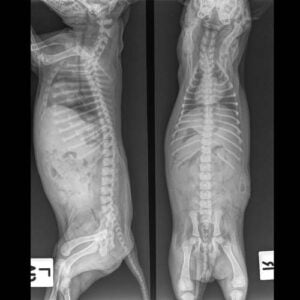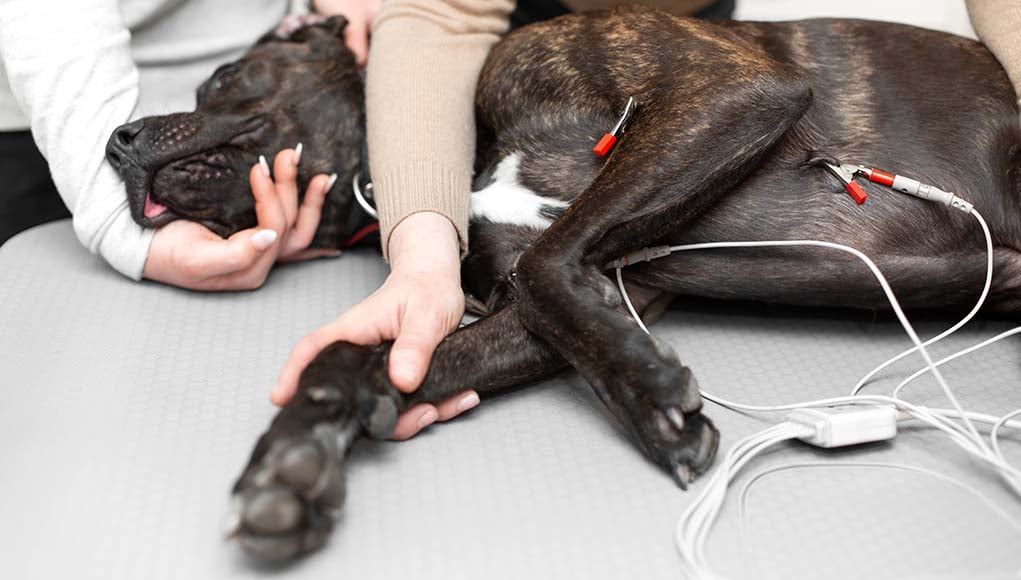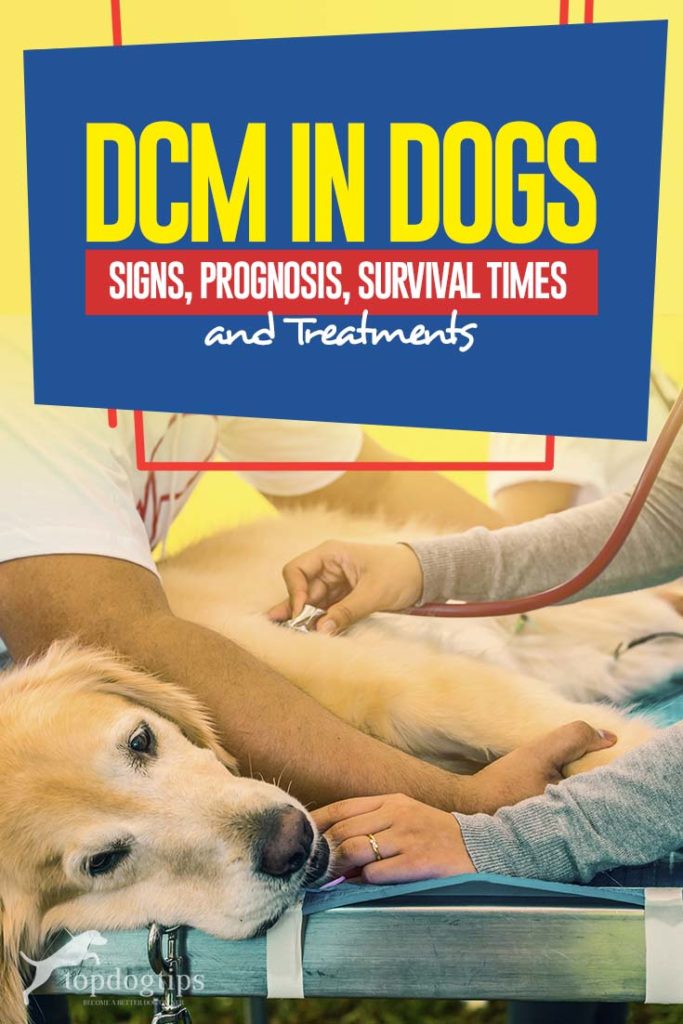Dilated Cardiomyopathy in dogs, or DCM, is one type of heart diseases that affects a dog’s heart muscle. The heart muscle becomes weak and decreases its ability to effectively oxygenate and pump blood through the dog’s body. Additionally, the heart muscle enlarges and causes fluid buildup in the lungs.
Dilated Cardiomyopathy is a subgroup of cardiovascular disease, which is the 4th most common cause of death in dogs (1). DCM in itself is the 2nd most common form of heart disease in dogs, which makes up about 10% of cardiac diagnoses (2).
DCM is rare in small breeds, and far more common in medium and large dogs. It's also more common in male dogs than female dogs (3). Here's everything else that you should know about DCM in dogs.
Signs and Symptoms
The age of onset of DCM in dogs varies between 3 and 7 years old (4). The signs of muscle thinning and dilation in dogs cannot be seen without testing. However, several retrospective studies found specific symptoms for owners to watch for (5).
Dilated Cardiomyopathy is characterized by dilation of the ventricles with ventricular wall thinning. Dilation of all four chambers of the dog's heart will be seen. The ability of the dog's heart to serve as a pump gets diminished, and clinical signs of this condition occur secondary to either decreased delivery of oxygenated blood to the dog's body, or to congestion of blood in the lungs (6).
The symptoms associated with a lack of blood flow due to a weakened heart muscle include:
- weakness
- decrease in weight
- sluggishness,
- loss of consciousness
The symptoms associated with a buildup of fluid in the lungs due to an enlarged heart include:
- difficulty breathing
- increased respiration
- coughing
- abdominal distention
If the dog is experiencing both lack of blood flow and an enlarged heart it may exhibit a combination of the above symptoms.
If a dog is exhibiting these symptoms, they should be taken to a veterinarian immediately for diagnosis and potential treatment. The symptoms caused by DCM will not go away on their own and are potentially life threatening.
Causes of DCM in Dogs
It a common misconception that taurine deficiency is the primary cause for DCM. While it is possible that a lack of taurine or other nutrients, such as L-carnitine, in a dog’s diet may increase the risk of DCM in some dog breeds, but it is not true for all dog breeds (7).
The primary cause is believed to be hereditary, with some dog breeds being affected more than others (4, 5, 8, 9).
The following dog breeds as being most at risk for DCM:
- Doberman Pinscher
- Great Dane
- Boxer
- Cocker Spaniel
- Afghan Hound
- Dalmatian
- English Bulldog
- Irish Wolfhound
- Newfoundland
- Bernard
- Scottish Deerhound
The Cocker Spaniel is one high-risk breed that may be negatively affected by taurine deficiency.
Other breeds that are at risk for taurine deficiency include:
- English Setter
- Golden Retriever
- Labrador Retriever
- Newfoundland
- St. Bernard
The Boxer and Great Dane are the two at-risk dog breeds that may be negatively affected by carnitine deficiency.
To ensure that a dog is getting enough of the nutrients that their body needs to properly function, check the nutrition facts label on their dog food label. In some cases, a veterinarian may suggest supplementation. Boxers and Cocker Spaniels are the most likely to benefit from carnitine supplementation.
It is important to note that only supplements made specifically for dogs should be used. Dogs should never be given supplements produced for humans, even if they're designed for DCM, unless specifically directed by a veterinarian.
Tests and Diagnosis for DCM in Dogs
 There are three different types of tests that a veterinarian might use to diagnose DCM in dogs. Each test helps to evaluate different parts of the dog’s heart or lungs. The first of the three tests is to diagnose DCM, and the next two are to get an understanding of how advanced the condition is.
There are three different types of tests that a veterinarian might use to diagnose DCM in dogs. Each test helps to evaluate different parts of the dog’s heart or lungs. The first of the three tests is to diagnose DCM, and the next two are to get an understanding of how advanced the condition is.
The first test is an echocardiogram. An echocardiogram helps to diagnose DCM by showing the dilation of the heart’s four chambers. It will also show the heart’s ability to pump and oxygenate blood, or it will show if the heart has become weak and the abilities to function normally have started to decline.
The second test is thoracic imaging. Thoracic imaging, or thoracic radiography, can be used to take different images of the dog; the three most common views taken are the right side, the left side, and lateral images. The images help to identify any buildup of fluids in the lungs as well as show the health of vessels and tissue in the lungs. The area around the lungs can also be viewed.
The third test is an electrocardiogram. This test can be done relatively quickly to determine the dog’s heart rhythm and possibly identify any irregular beats, or arrhythmias. Sometimes a veterinarian may recommend a longer testing period to get a more accurate picture of how well the heart is functioning. In order to test for a longer period of time, a Holter monitor may be worn for a period of 24 hours.
In addition to these three tests, a veterinarian will listen to a dog’s heart with a stethoscope, may run blood tests or x-rays.
Treatment Plan
Once testing has been completed, a diagnosis has been made, and the extent of the damage has been determined, a treatment plan may be suggested (7).
There are a few different treatment plans that a veterinarian might use to help alleviate the dog’s DCM symptoms. In severe cases a veterinarian might administer medication via injection to quickly respond to the symptoms that a dog is exhibiting. In less severe cases a veterinarian might prescribe medication for the dog to take on a routine basis at home (10).
Prognosis for Dogs with DCM
Unfortunately, the survival times for dogs with DCM are very poor (3). One study found the probability of survival at 1 year to be 37.5% and at 2 years to be 28% (11). Survival times vary, however: some may live a few weeks, while other dogs will live for a few months.
Generally, after developing clinical symptoms, the survival time for dogs with DCM has been estimated at approx 34 weeks, average (12, 13).
There is no cure for DCM in dogs, and it is typically a rapidly moving disease; however, a dog can go on to live a comfortable life depending on how early the diagnosis is made (6).
If a dog has not reached the congestive heart failure stage and receives treatment early in their diagnosis they may live a comfortable life and their symptoms may be relieved through treatment. If a dog is in congestive heart failure medical treatment may not be an option. When DCM is left untreated or undiagnosed there is a possibility of sudden death.
The prognosis can also vary depending on the dog’s breed. Cocker Spaniels rate of decline once diagnosed with DCM is very slow moving. They are more likely to live comfortably with DCM than most other dog breeds at the same stage and with the same treatment plan. Doberman Pinschers, on the other hand, can rapidly deteriorate and their condition may not ever improve, even with the addition of medications. The typical
READ NEXT: How to Prevent a Dog Heart Attack














